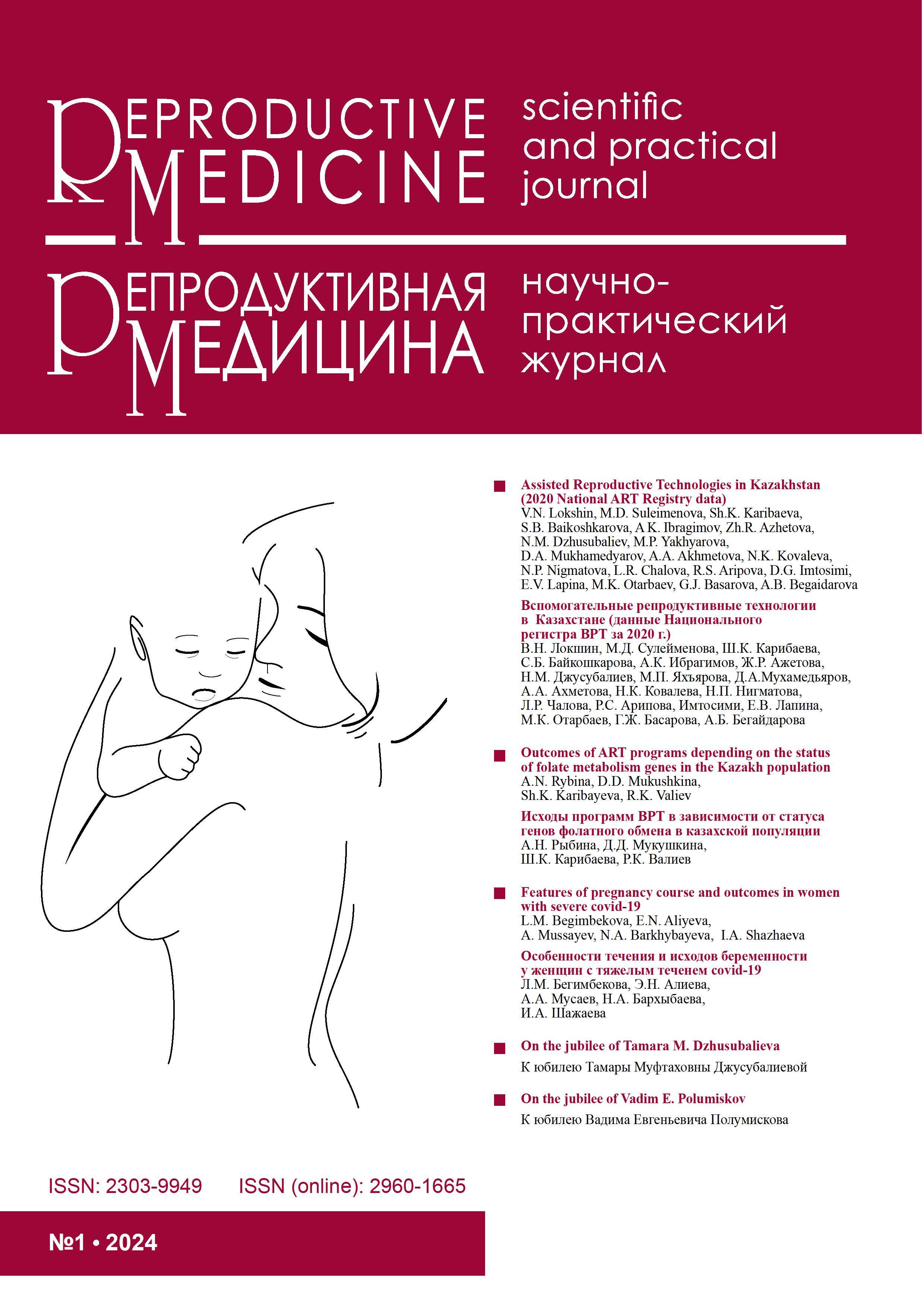Assisted Reproductive Technologies in Kazakhstan (2020 National ART Registry data)
DOI:
https://doi.org/10.37800/RM.1.2024.8-16Keywords:
assisted reproductive technologies (ART), 2020 ART report, IVF, ART accessibilityAbstract
Relevance: The article presents aggregate data on the programs of assisted reproductive technologies (ART) implemented in 2020 in Kazakhstani clinics specializing in treating infertility using ART.
The study aimed to analyze the structure and results of ART cycles conducted and Registered in the Republic of Kazakhstan from 1 January 2020 to 31 December 2020.
Materials and Methods: A retrospective analysis of data from reports of 17 ART clinics in Kazakhstan, which were voluntarily submitted to the Kazakhstan Association of Reproductive Medicine (KARM), was conducted. The reports included information on IVF cycles, ICSI, embryo cryopreservation, oocyte donation (OD), surrogacy, and preimplantation genetic testing (PGT).
Results: The total number of ART cycles available for analysis in 2020 was 17,743, resulting in the birth of 5,932 newborns. The accessibility of ART treatment amounted to 952 cycles per 1 million population.
Analysis of the ART structure revealed that IVF cycles accounted for 11.9% of all ART cycles in clinics in Kazakhstan, while ICSI was 33.4%.
A combined method of fertilization, using both IVF and ICSI (50/50), was performed in 13.0% of cycles. Frozen embryo transfer (FET) was conducted in 47.4% of cycles, while OD programs were carried out in 11.4% of cycles and PGT in 5.3% of cycles.
The pregnancy rate per aspiration in 2020 was 20.9% for IVF cycles, 20.4% for ICSI cycles, and 42.5% for FET cycles. When calculated per transfer, the pregnancy rate was 38.5% for IVF cycles and 39.5% for ICSI cycles. For OD programs, the pregnancy rate per aspiration was 50.6%. In 2020, live birth rates were 30.7% in fresh IVF cycles, 32.4% in ICSI cycles, 33.4% in FET cycles, and 42.0% in OD programs.
In 2020, 1,103 programs were conducted in Kazakhstan. The Registry of pregnant women and women of fertile age reported the pregnancy rate of 46%, the live birth rate of 26%, and the frequency of multiple births of 21.8%.
Conclusion: According to the Registry, the number of ART programs increased by 1.1% in 2020 vs. the previous year. The negative impact of COVID-19 on this indicator is unquestionable. The pregnancy and live birth rates remained stable and corresponded to the average ESHRE indicators.
References
World Health Organization. Infertility prevalence estimates, 1990-2021 [Internet]. Geneva: WHO; 2023 [cited 2024 February 21]. 98p. ISBN 978-92-4-006831-5.
https://www.who.int/publications/i/item/978920068315
Министерство национальной еькономики Республики Казахстан Комитет по статистике, ЮНФПА Казахстан. Анализ положения в области народонаселения в Республике Казахстан. – ЮНФПА, 16.01.2020.
Ministry of National Economy of the Republic of Kazakhstan Statistics Committee, UNFPA Kazakhstan. Analysis of the population situation in the Republic of Kazakhstan. – UNFPA, 16.01.2020. (in Russ).
https://kazakhstan.unfpa.org/sites/default/files/pub-pdf/АНАЛИЗ%20ПОЛОЖЕНИЯ.pdf
Локшин ВН, Карибаева ШК, Омар МД. Доступность лечения бесплодия с помощью врт в различных социально-экономических группах. Обзор литературы. Репрод Мед. 2019;3(40):8-12.
Lokshin VN, Karibaeva ShK, Omar MD. The availability of infertility treatment using ART in various socio-economic groups: A literature review. Reprod Med. 2019;3(40):8-12. (in Russ.).
https://repromed.kz/index.php/journal/issue/view/3/13
Lokshin VN, Karibaeva ShK, Omar MD. The availability of infertility treatment using ART in various socio-economic groups: A literature review. Reprod Med. 2019;3(40):8-12.
Lokshin VN, Karibaeva ShK, Omar MD. Dostupnost' lecheniya besplodiya s pomoshh'yu vrt v razlichnyx social'noe'konomicheskix gruppax. Obzor literatury. Reprod Med. 2019;3(40):8-12. (in Russ.).
https://repromed.kz/index.php/journal/issue/view/27
Lokshin V, Omar M, Karibaeva S. Assisted Reproductive Technologies in the Republic of Kazakhstan: A 6-Year Trend Analysis from Efficacy to Availability. J Reprod Infertil. 2022;23(1).
https://doi.org/10.18502/jri.v23i1.8454
Wyns C, De Geyter C, Calhaz-Jorge C, Kupka MS, Motrenko T, Smeenk J, Bergh C, Tandler-Schneider A, Rugescu IA, Goossens V. ART in Europe, 2018: results generated from European registries by ESHRE. Hum Reprod Open. 2022;2022(3):hoac022.
https://doi.org/10.1093/HROPEN/HOAC022
Бюро национальной статистики Агентства по стратегическому планированию и реформам Республики Казахстан. Демографические характеристики. Рождаемость.
Bureau of National Statistics of the Agency for Strategic Planning and Reforms of the Republic of Kazakhstan. Demographic characteristics. Fertility. 21.02.2024. (in Russ.).
Downloads
Published
How to Cite
Issue
Section
License
Copyright (c) 2024 The rights to a manuscript accepted for publication are transferred to the Journal Publisher. When reprinting all or part of the material, the author must refer to the primary publication in this journal.

This work is licensed under a Creative Commons Attribution-NonCommercial-NoDerivatives 4.0 International License.
The articles published in this Journal are licensed under the CC BY-NC-ND 4.0 (Creative Commons Attribution – Non-Commercial – No Derivatives 4.0 International) license, which provides for their non-commercial use only. Under this license, users have the right to copy and distribute the material in copyright but are not permitted to modify or use it for commercial purposes. Full details on the licensing are available at https://creativecommons.org/licenses/by-nc-nd/4.0/.




